Which Hydroponic System is Right for You?
How can you start a home hydroponic farm? Learn about the different ways to grow plants hydroponically and decide which hydroponic system makes the most sense for you.
At Vertical Roots, we’ve rigorously tested multiple styles of hydroponics (and aeroponics too) and custom-designed our system to grow the best, most delicious lettuce possible. But what works for our container farms probably won’t be the best option for your home garden. If you’re looking to grow herbs in your kitchen or tomatoes in your greenhouse but you don’t want to design high-tech software or undertake a major construction project to do it, you’ve come to the right place.
To get a better idea of your needs before you begin, try asking yourself the following questions:
- How much space do I have?
- What am I willing to spend?
- How much time do I have to monitor my garden?
- Do I really want delicious, home-grown produce year-round?!
Alright – ready to explore? Check out our roundup of the emost common hydro options below.
Note: no matter what system you choose, you will need some basic elements like appropriate lighting and a growing medium (the material serving as your plant’s root-support system)
Kratky
Pros: Easy to set up, a breeze to maintain
Cons: Not suitable for diverse gardens, works best for growing individual plants
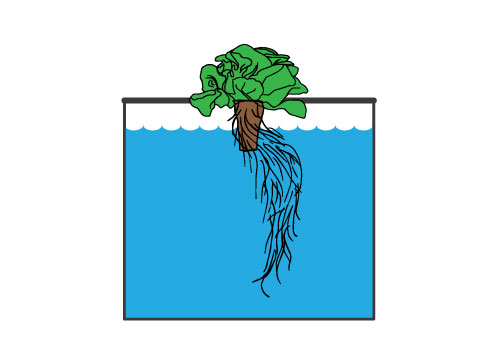
The Kratky method is the most basic of all growing approaches. This method doesn’t require any electricity, water-circulating equipment, or air pumps. It is, however, limited to smaller production. If you just want to grow a small plant or two for your house and you’re not sure you have the time to tinker with more complex setups, this is probably your dream. If you’re planning on growing a highly productive and robust vegetable garden, then Kratky is unlikely to get you there as it doesn’t support the hefty water and nutrient needs of larger plants.
To set up this system, you just need a container (even a mason jar will do), a net pot, and some nutrients. Instead of submerging the roots in oxygenated water, you simply fill your container until the water covers about a third of your net pot. Then you can let the plant do the work itself!
As your seedlings continue to suck up water/nutrients, they will create an air pocket in the tank, taking care of oxygenation for you. Think of this as self-watering and self-oxygenating.
Some things to look out for: Even thought this system allows you to mostly “set it and forget it,” you can’t forget to test your pH levels and add nutrients intermittently. It’s also easier for plants to develop root rot in this setup and die before a sufficient bubble of oxygen is created between the base of the plant and the reservoir. If this system leaves you wanting, we suggest stepping up your hydroponic game just a smidge with Deep Water Culture.
Deep Water Culture
Pros: Easy to customize, effective for a broad range of plants
Cons: Plants are subject to root rot if oxygen levels aren’t closely monitored
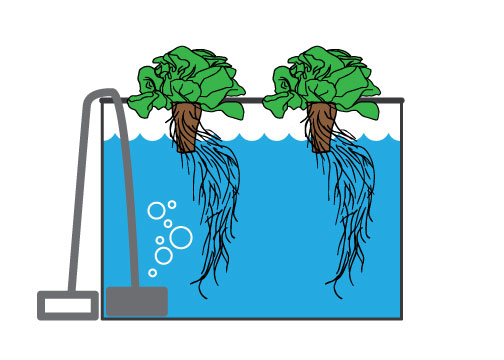
Deep Water Culture (or DWC) is the godfather of hydro and is one of the more common setups you’ll encounter. In essence, this approach involves suspending plants in a nutrient system and waiting for magic to happen. Like Kratky, as your seedling sprouts roots, they will suck up nutrients and hit a serious growth spurt. Unlike the Kratky method, your net pots will be constantly submerged in nutrients with no gap between the plant and the reservoir.
Just like you can overwater a plant in soil, you can “drown” your plants in a hydroponic system. You can solve the oxygenation problem in two ways: by adding an air stone to the container to produce oxygen bubbles, and by installing an air pump. There’s a reason DWC is such a commonly used system for home growers: it’s relatively simple, doesn’t require much space, and is more consistently successful than the Kratky approach.
Nutrient Film Technique
Pros: Ability to constantly adjust inputs for optimum growth
Cons: Requires more time, money, and expertise to set up and maintain
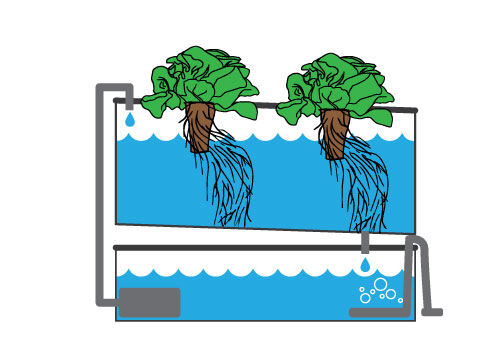
If you want to dive right into the hydro deep end, you can go all out with the Nutrient Film Technique (NFT). Like most setups, the basic idea is the same: you arrange your plants so that the roots have contact with oxygen and nutrients. But this next-level system ensures that your plants have a constant flow of both elements in ideal amounts.
NFT involves the use of a reservoir and a pump system. Plants are aligned in a row on a slight angle so that your nutrient solution can flow down the channel into the reservoir, feeding the roots in a steady stream as it makes the journey. Once the water reaches the end of the line, it’s re-dosed with nutrients and pumped back up to the starting point to begin again.
NFT is awesome if you’re tech-savvy and can monitor the system the majority of the time. But as they say, with more complexity comes more opportunities for catastrophe. Since the roots are only getting a thin “film” of water and nutrients, if something goes wrong with the pump and you’re not around to troubleshoot, your roots can quickly dry up and you could lose the whole crop.
Ebb and Flow
Pros: High customizability, lower energy requirements than NFT
Cons: Additional expertise required to set up automation
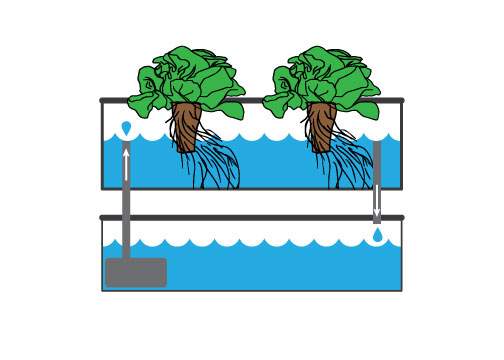
This approach still requires a bit of engineering prowess on the part of the grower, but is more simplistic than NFT. If you choose this route, your efforts are rewarded with hyper-customizability. Ebb and flow systems work by flooding the growing medium with nutrients and water at predetermined intervals, after which the solution is drained back into a reservoir.
Automation is the name of the game here. To effectively manage your ebb and flow setup, install a submersible pump with a timer and set up your watering schedule in accordance with the plant size, number of plants, base temperature, and so on. Technically, you can simply fill a tray with water and nutrients and drain it by hand after an appropriate amount of time. However, this sort of hands-on upkeep would keep you tethered to your system all day, which isn’t likely to be sustainable!
This is an awesome approach if you’re looking for a versatile setup to support a variety of plants. If you don’t have the space to place your plants in a long row but you still want a high level of customizability, you may want to try this next variation instead.
Drip
Pros: Flexible setup to fit any space, can easily be used for a single plant or many plants
Cons: High maintenance requirements if you want to recycle the water in your reservoir
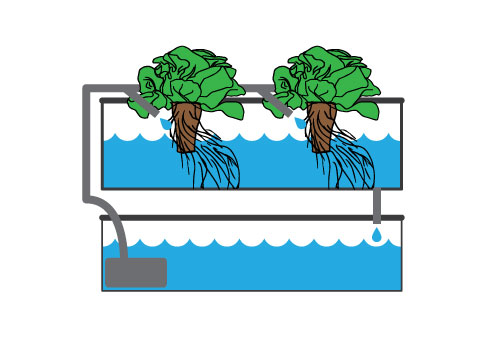
A drip system uses two pumps, a reservoir, and a series of hoses to keep your plants healthy and happy. Here’s the deal: the air pump keeps the water and nutrient solution moving and oxygenated, while a second pump moves the solution up through perforated hoses that drip nutrients onto your plants. In this approach, since the water moves from the top down instead of the bottom up, roots are totally embedded in a growth medium instead of hanging free to gather food from a reservoir below.
This method works best if you sprout your seeds in a smaller container with a growth medium like coconut coir and then transfer your “teenage” plants to larger pots filled with a more porous medium like vermiculite.
Which system is the winner for you?
Let us know how things go by sharing a picture of your setup on Instagram and tagging @verticalroots!